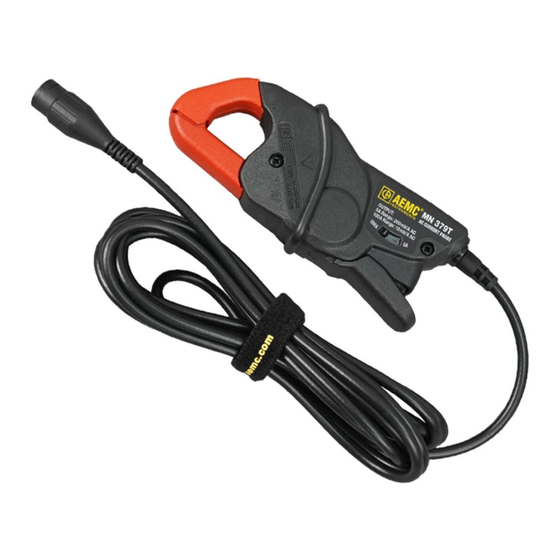
Advertisement
Quick Links
AC Current Probe
Model MN379T
User Manual
DESCRIPTION
The MN379T (Cat. #2153.02) is the latest in compact AC current probes. Designed to meet the
most stringent demands in industry and electrical contracting, it also meets the latest safety
and performance standards. The probe has a measurement range up to 120 A
and resolution capable of displaying 10 mV of output per amp of measured current, a voltmeter
accuracy of 0.5 % or better to take full advantage of the accuracy of the probe and an input
impedance of ≥ 1 M
WARNING
These safety warnings are provided to ensure the safety of personnel and proper operation of
the instrument. Read the instruction manual completely and follow all the safety information
before attempting to use or service this instrument.
ƒ The safety warnings are provided to ensure the safety of personnel and proper operation of
the instrument. Read the instructions completely.
ƒ Use caution on any circuit: potentially high voltages and currents may be present and may
pose a shock hazard.
ƒ Do not use the probe if damaged. Always connect the current probe to the measuring
device before it is connected around the conductor.
ƒ Do not use on non-insulated conductor with a potential to ground greater than 600 V CAT III
pollution 2. Use extreme caution when clamping around bare conductors or bus bars.
ƒ Before each use, inspect the probe; look for cracks in housing or output cable insulation.
ƒ Do not use clamp in wet environment or in locations that hazardous gases exist.
ƒ Do not use the probe anywhere beyond the tactile barrier.
INTERNATIONAL ELECTRICAL SYMBOLS
Signifies that the instrument is protected by double or reinforced insulation.
CAUTION - Risk of Danger! Indicates a WARNING. Whenever this symbol is
present, the operator must refer to the user manual before operation.
Application or withdrawal authorized on conductors carrying dangerous voltages.
Type A current sensor as per IEC 61010-2-032.
DEFINITION OF MEASUREMENT CATEGORIES
CAT IV:
Corresponds to measurements performed at the primary electrical
supply (< 1000 V).
Example: primary overcurrent protection devices, ripple control units, and meters.
CAT III:
Corresponds to measurements performed in the building installation at the
distribution level.
Example: hardwired equipment in fixed installation and circuit breakers.
CAT II:
Corresponds to measurements performed on circuits directly connected to the
electrical distribution system.
Example: measurements on household appliances and portable tools.
RECEIVING YOUR SHIPMENT
Upon receiving your shipment, make sure that the contents are consistent with the packing
list. Notify your distributor of any missing items. If the equipment appears to be damaged,
file a claim immediately with the carrier, and notify your distributor at once, giving a detailed
description of any damage.
Ω
.
, a range
RMS
Advertisement

Summary of Contents for AEMC instruments MN379T
- Page 1 User Manual DESCRIPTION The MN379T (Cat. #2153.02) is the latest in compact AC current probes. Designed to meet the most stringent demands in industry and electrical contracting, it also meets the latest safety and performance standards. The probe has a measurement range up to 120 A...
- Page 2 AC CURRENT PROBE - MN379T 2.56 in (65 mm) 73 in .83 in (21 mm) (18.5 mm) 2.00 in (51 mm) 1.18 in (30 mm) ELECTRICAL SPECIFICATIONS *Reference conditions: (18 to 28) °C, (20 to 75) % RH, external magnetic field Nominal Range: 5 A, 100 A <...
- Page 3 Please make sure that you have already read and fully understand the WARNING section on page 1. Making Measurements with the AC Current Probe Model MN379T ƒ Connect the BNC connector to your voltage-measuring instrument. The AC current probe has an output of 200 mV/A and 10 mV/A. This means that with the probe in the 10 mV/A...
- Page 4 Tips for Making Precise Measurements ƒ When using a current probe with a meter, it is important to select the range that provides the best resolution. Failure to do this may result in measurement errors. ƒ Make sure that probe jaw mating surfaces are free of dust and contamination. Contaminants cause air gaps between the jaws, increasing the phase shift between primary and secondary.
















Need help?
Do you have a question about the MN379T and is the answer not in the manual?
Questions and answers